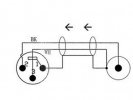Hey,
so I have following problem: my KEF LSX broke down after only 2 years and 11 months. I sent them to KEF already but I have a feeling that it will cost me some money I am not willing to spend on these speakers anymore. That’s why I was looking around for a replacement and I am thinking about a pair of Genelec G Three (not the 8030C because of the input). However, I already have a working KEF Kc62 at home and I wanna keep using them. Now, what would be the best (and maybe cheapest) way to integrate that sub. The only thing I currently have is a Topping DX3 Pro.
so I have following problem: my KEF LSX broke down after only 2 years and 11 months. I sent them to KEF already but I have a feeling that it will cost me some money I am not willing to spend on these speakers anymore. That’s why I was looking around for a replacement and I am thinking about a pair of Genelec G Three (not the 8030C because of the input). However, I already have a working KEF Kc62 at home and I wanna keep using them. Now, what would be the best (and maybe cheapest) way to integrate that sub. The only thing I currently have is a Topping DX3 Pro.



